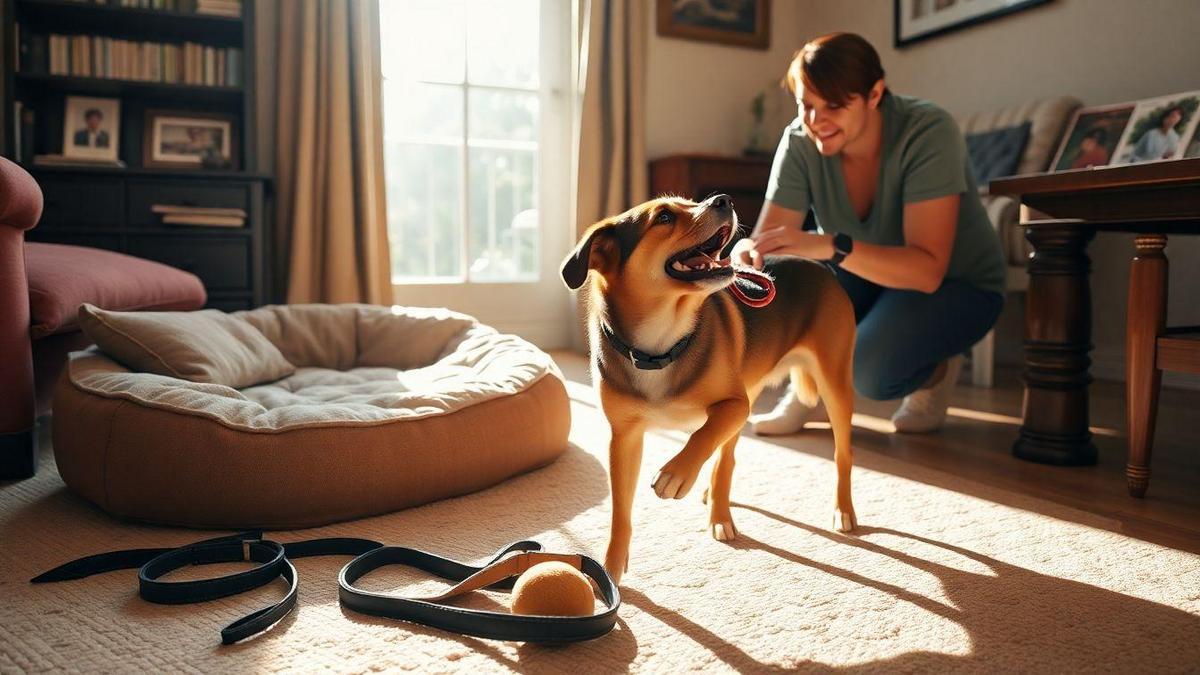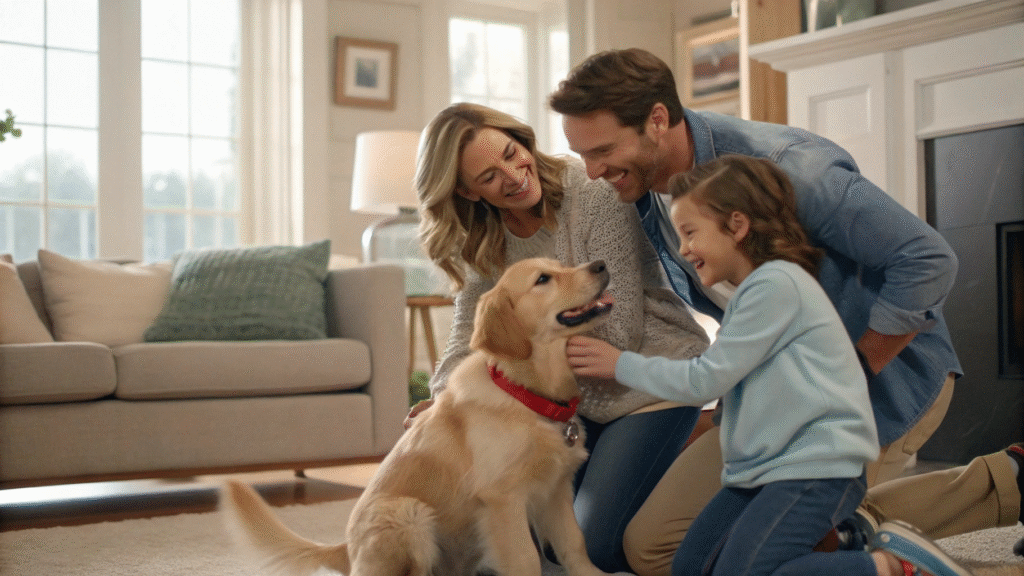5 Essential Tips for Dog Adoption can make this process easier and more rewarding.
If you’re thinking about bringing a furry friend into your life, you’re in for an exciting journey!
This article will guide you through every step, from understanding the pet adoption process to preparing your home. You’ll learn how to choose a dog that fits your lifestyle, care for your new pet, and even some important training tips. Let’s dive into the amazing world of dog adoption together!
Key Takeaways
- Choose the right breed for your lifestyle.
- Visit local shelters for adoption options.
- Prepare your home for a new dog.
- Budget for food, vet, and supplies.
- Spend time training and bonding with your dog.

Summary
Why You Should Consider Dog Adoption
So, you’re thinking about getting a dog? That’s awesome! But have you considered dog adoption? There are many reasons to adopt rather than shop. First off, when you adopt, you’re giving a home to a pup who really needs it. Shelters are often overflowing with dogs waiting for their forever families.
Plus, adopting can save you money. Adoption fees are usually much less than buying a dog from a breeder. Many shelters include vaccinations and spaying or neutering in that fee. It’s like getting a great deal on a new best friend!
Adopting a dog can also be a rewarding experience. You’ll witness your new furry friend blossom in a loving home. And let’s be honest, there’s nothing quite like the joy of seeing a dog wag its tail when it realizes it’s finally safe and loved.
If you’re worried about breed, you might be surprised. Shelters have all kinds of breeds, sizes, and ages. Whether you want a tiny lap dog or a big, energetic companion, there’s likely a pup waiting for you. So, why not give a rescue dog a chance? You could change a life, and in return, you’ll get a loyal friend for life.
Understanding the Pet Adoption Process
Alright, let’s get into the nitty-gritty of the pet adoption process. It can seem a bit overwhelming, but it’s really not that bad once you break it down.
First, research local shelters or rescue groups. Check out their websites or social media pages to see what dogs they have available. Some places even have virtual meet-and-greets!
Once you’ve found a dog that catches your eye, the next step is usually filling out an application. This often involves answering questions about your living situation, experience with pets, and what you’re looking for in a dog. Don’t sweat it; they just want to ensure you’re a good match for each other.
After that, many shelters will want to conduct an interview. This might be a casual chat about your lifestyle and how you plan to care for your new dog. They’re not trying to grill you, just ensuring that you and the dog will be a good fit.
Some places might even require a home visit. This is just to ensure your home is safe and ready for a pup. If everything checks out, congratulations! You’ll get to take your new furry friend home. Just remember, the process might vary a bit from one shelter to another, so it’s good to check their specific requirements.
Choosing the Right Dog for Your Lifestyle
Now, let’s talk about how to choose the right dog for your lifestyle. This is super important! You want to ensure your new pup fits in well with your daily routine and personality.
First off, think about your activity level. Are you a couch potato who loves binge-watching shows? Or are you a fitness junkie who runs marathons? Different dogs have different energy levels. A high-energy dog like a Border Collie might not be the best match for someone who prefers a laid-back lifestyle.
Next, consider the size of your living space. If you live in a small apartment, a giant breed might not be the best choice. Smaller dogs or those with lower exercise needs could be a better fit.
Also, think about your family situation. Do you have young kids? Some breeds are known for being great with children, while others might not have the patience. It’s also worth considering if you have other pets at home. Some dogs do better in a multi-pet environment than others.
And don’t forget about grooming needs! Some breeds require regular grooming and maintenance, while others are pretty low-maintenance. If you’re not up for regular trips to the groomer, you might want to stick with a dog that has a simpler coat.
Finally, it’s a good idea to spend some time with the dog before making a decision. Many shelters allow you to take the dog for a walk or spend some time in a play area. This can give you a feel for their personality and help you see if you click.
5 Essential Tips for Dog Adoption: Preparing Your Home
So, you’ve decided to adopt a dog! That’s fantastic! But before you bring your new furry friend home, you’ll need to prepare your space. Here are five essential tips to get your home ready for your new pup.
- Dog-Proof Your Home: Just like you would for a toddler, you need to make your home safe for your new dog. This means putting away things they might chew on, like shoes, electrical cords, and any small items they could swallow. Also, secure trash cans and keep harmful substances out of reach.
- Create a Cozy Space: Dogs need a place to feel safe and comfortable. Set up a cozy bed in a quiet corner of your home where they can relax. You might also want to add some toys and blankets to make it feel more inviting.
- Stock Up on Supplies: Before your dog arrives, get all the essentials. You’ll need food and water bowls, high-quality dog food, a collar and leash, toys, and grooming supplies. Don’t forget some treats for training, too! If you’re unsure about what to feed your new pup, explore the best dog food options.
- Plan for Exercise: Dogs need regular exercise to stay healthy and happy. Think about how you’ll incorporate walks and playtime into your daily routine. If you have a yard, make sure it’s secure and safe for your new pup to explore. Regular walks can also improve your dog’s behavior.
- Consider Training: Training is super important for a well-behaved dog. Look into local training classes or resources. Even just teaching basic commands like sit and stay can make a big difference in your relationship with your new dog. For first-time owners, dog first aid tips can also be beneficial.
Getting your home ready for a dog takes effort, but it’s totally worth it. You want your new furry friend to feel welcome and safe right from the start!
Dog Care Essentials for New Owners

Now that you’ve prepared your home, let’s talk about some dog care essentials every new owner should know. It might seem like a lot at first, but once you get into a routine, it’ll become second nature.
First up, feeding. Make sure you’re giving your dog a balanced diet suitable for their age and size. Puppies, adults, and seniors all have different nutritional needs. And don’t forget to provide fresh water daily!
Next, regular vet visits are crucial. Your new pup will need vaccinations and check-ups to stay healthy. It’s also a good idea to discuss spaying or neutering with your vet if it hasn’t been done already. Consider looking into dog insurance options to help cover these costs.
Grooming is another essential. Depending on the breed, your dog might need regular brushing, bathing, and nail trimming. Even if you have a short-haired dog, regular brushing helps reduce shedding and keeps their coat healthy.
Exercise is key for a happy dog. Daily walks, playtime, and mental stimulation are all important. Dogs can get bored just like us, so keep things interesting with toys and activities.
Lastly, don’t forget about socialization. Exposing your dog to different people, pets, and environments helps them become well-adjusted. Just take it slow and make sure they’re comfortable.
Taking care of a dog is a big responsibility, but the love and companionship they bring make it all worthwhile.
Understanding Dog Behavior: What to Expect
Getting a new dog means you’ll need to understand dog behavior. This can help you bond with your pup and address any issues that come up.
First, remember that dogs communicate through body language. A wagging tail usually means they’re happy, while a tucked tail can indicate fear. Learning to read your dog’s signals will help you understand how they’re feeling.
Also, dogs can be a bit anxious when they first come home. It’s a big change for them! You might notice them acting shy or hiding at first. Give them time to adjust. Create a calm environment and let them explore at their own pace.
Barking is another behavior you’ll encounter. Dogs bark for various reasons, like alerting you to something or just wanting attention. It’s important to understand why your dog is barking so you can address it appropriately.
And let’s not forget about play! Playtime is essential for a dog’s happiness. It’s a way for them to express themselves and bond with you. Different dogs have different play styles, so pay attention to what your pup enjoys.
Lastly, remember that training is a key part of understanding dog behavior. Teaching commands helps your dog know what you expect from them. It also strengthens your bond.
Understanding your dog’s behavior takes time, but it’s a rewarding part of being a pet owner.
Training Tips for Your New Rescue Dog
Training your new rescue dog might seem daunting, but it doesn’t have to be! Here are some training tips to help you get started on the right paw.
First, be patient. Your new dog might not know what you want right away. It’s important to give them time to learn. Celebrate small victories! Even if they just sit for a second, that’s a win.
Positive reinforcement works wonders. Use treats, praise, or playtime as rewards when your dog does something right. This encourages them to repeat the behavior. Just be consistent with your commands and rewards.
Start with basic commands. Sit, stay, come, and down are great foundations. Keep training sessions short and fun, around 5 to 10 minutes, so your dog doesn’t lose interest.
Socialization is also a huge part of training. Expose your dog to different people, pets, and environments. This helps them become more confident and well-adjusted. Just remember to take it slow and let them approach new experiences at their own pace.
And don’t forget about consistency! Use the same commands and rules across the board. If you let your dog jump on the couch sometimes but not others, it can confuse them. So, be clear about what’s allowed and what’s not.
Training a rescue dog can be a journey, but it’s so rewarding when you see them grow and learn. Plus, it strengthens your bond and makes for a happier home.
Responsible Pet Ownership: A Lifelong Commitment
Lastly, let’s talk about responsible pet ownership. Owning a dog is a lifelong commitment, and it’s important to understand what that means.
First and foremost, you’re responsible for your dog’s well-being. This includes providing food, shelter, and medical care. It’s not just a fun hobby; it’s a commitment to care for another living being.
Also, consider the time and energy you’ll need to invest. Dogs need daily exercise, training, and social interaction. Make sure you have the time to dedicate to your pup’s needs.
Financial responsibility is another factor. Dogs can be expensive. You’ll need to budget for food, vet visits, grooming, and supplies. It’s good to have an emergency fund, too, in case unexpected medical issues come up. Researching pet insurance options can help you manage these costs.
And let’s not forget about the long-term commitment. Dogs can live anywhere from 10 to 15 years or more, depending on the breed. Make sure you’re ready for that kind of commitment before bringing a dog into your life.
Being a responsible pet owner means being there for your dog through thick and thin. They’ll rely on you for everything, and in return, they’ll give you unconditional love and companionship. It’s a beautiful relationship, but it comes with responsibilities.
Conclusion
So, there you have it! Dog adoption is a thrilling journey filled with love, joy, and a few challenges along the way.
By following these essential tips for dog adoption, you’ll set yourself and your new furry friend up for a fantastic life together. From choosing the right breed to preparing your home and understanding dog behavior, each step is crucial for a happy, healthy relationship. Remember, adopting a dog is not just a one-time decision; it’s a lifelong commitment that brings endless rewards.
You’re not just giving a dog a home; you’re gaining a loyal companion who will fill your days with wagging tails and unconditional love. So, roll up your sleeves, get ready for some tail-wagging fun, and dive into the world of dog adoption!
And hey, if you’re hungry for more tips and insights, don’t hesitate to check out more articles at Tech Havela. Happy adopting! 🐾
Frequently Asked Questions
What are the 5 Essential Tips for Dog Adoption?
The 5 Essential Tips for Dog Adoption include researching breeds, visiting local shelters, preparing your home, considering the dog’s age, and being patient during the transition.
How do I choose the right dog for my family?
Think about your lifestyle! Active families might want a high-energy dog. If you’re more laid-back, a calm dog might suit you better.
Do I need to prepare my home for a new dog?
Yes, definitely! Remove any hazards and make a cozy space for your new furry friend. Safety is key!
How can I help my new dog adjust?
Give your dog time. Keep their routine simple and familiar. Be patient as they settle into their new home.
What if I have kids or other pets?
Make sure your dog is good with kids and other pets. Introduce them slowly and supervise all interactions.
Should I adopt a puppy or an adult dog?
It depends! Puppies need more time and training, while adult dogs may be calmer and already trained. Think about your schedule!
How long does the adoption process usually take?
It varies by shelter, but you may complete it in a few hours or a few days. Be ready to fill out some forms!
**Sidnir Vieira**
Founder of TechHavela
A passionate pet and tech content creator, helping dog owners across the U.S. make smarter decisions for their furry friends.



